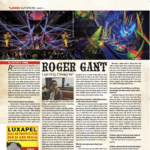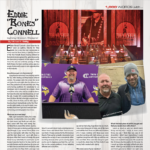Entertainment is certainly in Jason Rudolph’s DNA. As the fourth-generation member of the industry, he carries on his family’s rich legacy into new areas of technology. Having started out as a lighting programmer, his mix of projects these days is 95 percent visuals and media-based. He has a busy career as a screens programmer and producer as well as, at times, a video technical manager on massive live shows and televised events like the Oscars and the Super Bowl Halftime Show, music festivals, corporate events, and occasional concert tours and architectural installations.
These days he’s even moving into camera direction. While he keeps a good balance of work, 60-70 percent of his work is in TV. Between gigs and a well-earned summer break, PLSN got a chance to ask him a few questions.
PLSN: How’d you get into the industry?
Jason Rudolph: Both my great-grandfather and grandfather are 50 year members of IATSE Local One. My great-grandfather was a master electrician at the Hippodrome in the days of Vaudeville. Then, he worked at NBC when it was radio, which is also where my grandfather got started as a master electrician. He was ME for Bill Klages in the early TV days. He eventually started his own company, Lite-Trol, for service and install.
That’s how my dad got into the business. He and my mom moved down to Florida after college and he went to work at Stage Equipment and Lighting. My mom worked accounting for an audio company. On days off of school I’d go in to work with one of them; that’s how I caught the lighting and production bug. I learned to program my first console when I was 12. I went to school for engineering, but I kept gigging on the side, and after a couple years, I stopped going to school and started gigging full-time. I eventually took a position as a lighting engineer for the Univision Network, which is what got me into the television world. Then after a couple years, I left to start my own company, Mobius Productions, and I’ve just been going ever since.
So Univision was a big career point for you.
Yeah, that definitely was a big shake-up, moving to TV from clubs and events, it’s a very different way of doing things. I learned a lot there and I worked with some great people like Carlos Colina and Felix Peralta.
While I was at Univision, they got the Latin Grammys and that’s where I met Bob Dickinson. After doing that gig for two years with Univision, I was ready to move on, and Bob started bringing me onto other gigs. At the same time, Felix, was working with Allen Branton a lot. So, I also started doing gigs with them. I had come to know Tom Kenny as well, so pretty quickly I was in with quite a few of those groups getting work. You know, it’s a small world and, for the most part, if you can get on a gig and not screw up, you’ll be brought back somewhere.
I rarely turned anything down early on, and grew it from there. I was also aware, however that there is definitely a point where you get burned out. You’ve got to step back and say no every once in a while, because otherwise you burn out in an epic way at some gig. That can take years to overcome, so you have to be careful.
What do you think is an essential element needed in the screens producer and executive producer relationship?
Definitely communication is huge. That goes across anywhere, but certainly when dealing with visuals. Sometimes you show them a drawing or a video, and you have to know that everybody might be seeing something different. You might put up something that looks like flowers and a fence, and you think white picket fence in a nice small town. Someone else thinks ‘graveyard.’ Everybody sees something, but not always the same thing, so you have to communicate and you have to be flexible and able to roll with the punches.
I really enjoy the variety of my job. You never know what you’re going to get, which is good and bad. At the same time, I like the challenge of that. I also really like, and always have, the combination of the technical and the creative. Working with both sides of the brain is something that I’ve always really liked.
What do you consider some milestones in your career?
Definitely, across the board, the Super Bowl has always been one of my favorites. Especially the first year that I did it, in 2010. It was The Who in Miami, and I was working with Lee Lodge and Tom Kenny; that was definitely a big one for me. The World Expo in Shanghai, where I was a lighting director; as an event, it was really a milestone. I really enjoyed that one. Also, this past fall, The Desert Trip Festival. I was screens producer on it, and It was just a once-in-a-lifetime lineup of acts. And back to the Super Bowl, with Katy Perry [in 2015] — just from a technical and creative standpoint, it was pretty groundbreaking, what we achieved.
Similarly, a few years back, on the Oscars, we had 54 outputs of projection. We were doing massive textures for that time period. DreamWorks came to us and saying that they’d never rendered anything as big as this. That was pretty impressive. We were also doing automation tracking on multiple levels and all kinds of stuff that, for the time, was extremely groundbreaking, especially doing it all on the same show. We were all very proud of that show.
When I was involved in Obama’s inauguration in 2009, it was really neat because my grandfather sent me a copy of his credentials from when he worked on Kennedy’s inauguration with Bill Klages. He sent along a great note to me from both he and Klages about doing the inauguration; it was neat seeing a couple generations apart and we were all involved in similar groundbreaking moments in history. That was special.
Do you feel the tools and techniques are keeping up with people’s visions?
You’ve always got people who push the boundaries. A lot of the latest generation of servers and tools available to us are really, really powerful now. But like anything, you make things more powerful, and people want to do twice as much with them, so all of a sudden it’s not powerful anymore. At least it feels like it.
Certainly, the level of what we can do now is pretty impressive. It just means that now we can do things that before we couldn’t. Or, we’re doing the same things but in a tighter timeframe or with fewer worries than we used to have to. At the same time, there’s still stuff that we want to do that you can’t do yet, so it’s all a constant evolution.
Who have some of your mentors been?
Definitely Carlos Colina and Felix Peralta were big ones early on for me. Definitely Bob Dickinson, I’ve learned a lot from him. Also Lee Lodge, we worked together for a long time and grew together. I’d be remiss not to say my dad and my grandfather, as well, just for giving me my start and always being a good place to go to for perspective. My grandfather, Gene Rudolph, he’s 96 and he still likes to try to keep up on the industry. He’s quite an inspiration.
Michael S. Eddy is editor of Stage Directions magazine.


